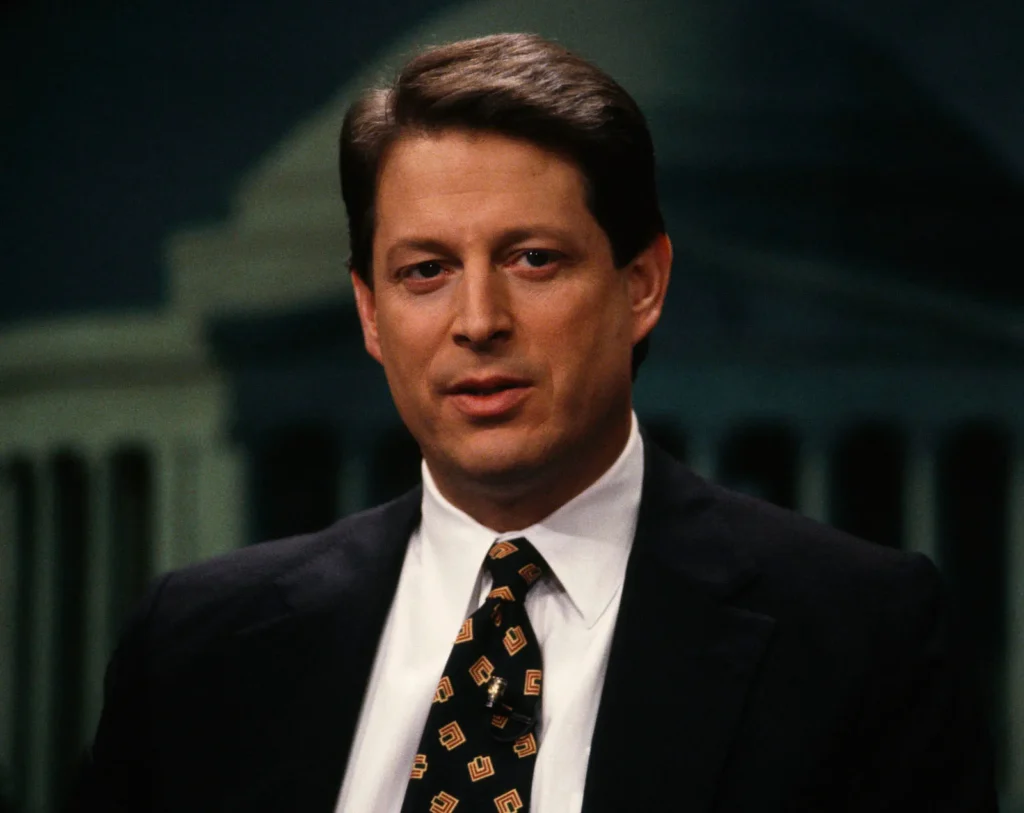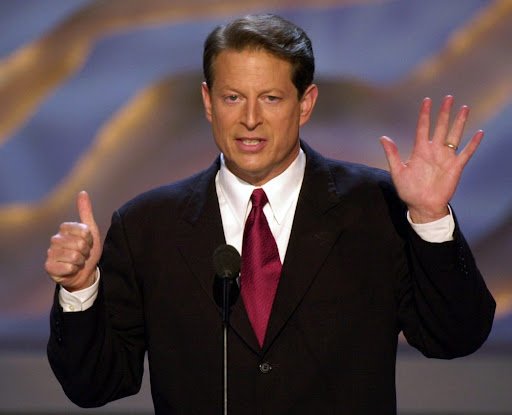Al Gore Then and Now
Al Gore Then
Al Gore, born on March 31, 1948, in Washington, D.C., grew up in a politically active family.
His father, Al Gore Sr., was a prominent U.S. senator, and his mother, Pauline LaFon Gore, was an advocate for women’s rights.
Despite being surrounded by politics, Gore experienced a unique upbringing that included spending time on his family’s farm in Carthage, Tennessee.
This balance between Washington, D.C.’s political scene and the rural life in Tennessee helped shape his perspective on the American landscape, from urban policy issues to environmental and agricultural concerns.
Gore’s leadership abilities emerged early, particularly during his high school years when he captained the football team.
He was known for his dedication, discipline, and strong work ethic—qualities that would later influence his political career. In 1965, he began studying at Harvard University, focusing on government.
There, he was deeply influenced by his professor Roger Revelle, a pioneer in climate science, who sparked Gore’s early interest in environmental issues.

Graduating in 1969, Gore faced a challenging period, as he was drafted for military service during the Vietnam War.
Though opposed to the war, he chose to serve, completing a brief tour as a military journalist in Vietnam.
This experience, coupled with his education, further motivated his pursuit of public service, instilling in him a commitment to both policy and environmental activism that would define much of his later career.
Related Article: Jimmy Carter Then and Now
Al Gore’s Political Career
Al Gore’s political career began in earnest in 1976 when he was elected to the U.S. House of Representatives, representing Tennessee’s 4th District.
His commitment to public service and political aspirations continued to grow, and in 1984, he successfully ran for the U.S. Senate, where he served as an influential voice on environmental issues, technology, and national security.
Despite being relatively young, Gore quickly earned a reputation for his knowledge of complex policy areas, particularly his advocacy for technological advancements and early warnings on climate change, topics that were not yet widely recognized as urgent.
In 1988, Gore made his first attempt at the presidency. At just 39, he was the youngest candidate in the race and focused on centrist policies.
Related Article: George W. Bush Then and Now
However, his campaign struggled to gain traction, particularly in the more competitive primaries, and he received only 10% of the popular vote in the New York primary, prompting him to withdraw.
Though his 1988 bid was unsuccessful, Gore remained a rising star within the Democratic Party. In 1992, he joined Bill Clinton’s presidential campaign as the vice-presidential candidate.
Together, they focused on economic revitalization, social reform, and a new environmental vision.
Their victory made Gore the 45th vice president of the United States, a role in which he worked to modernize government and championed environmental and technological initiatives, including the Information Superhighway, which contributed to the growth of the internet.
Related Article: Bill Clinton Then and Now

In 2000, after eight years as vice president, Gore launched a second bid for the presidency.
This time, he became the Democratic nominee, running a campaign that emphasized environmental issues, healthcare, and economic stability.
The election was one of the most contentious in American history, ultimately hinging on a Florida recount that was settled by the Supreme Court in favor of George W. Bush.
Although Gore lost the electoral vote, he won the popular vote, which intensified debate over the electoral system and sparked widespread controversy.
Related Article: Michelle Obama Then and Now
After the 2000 election, Gore shifted his focus to raising awareness about climate change.
In 2006, he released An Inconvenient Truth, a groundbreaking documentary based on his environmental advocacy and research.
The film highlighted the dangers of global warming, popularizing the issue for a global audience and invigorating the environmental movement.
Related Article: Jeff Flake Then and Now
An Inconvenient Truth won an Academy Award for Best Documentary, affirming its influence and impact.
Gore continued his environmental work with a follow-up documentary, An Inconvenient Sequel: Truth to Power, in 2017.
Through his films, activism, and continued advocacy, Gore’s post-political career solidified his role as a leading voice in the fight against climate change.
Related Article: John Hickenlooper Then and Now
Al Gore’s Wife and Children
Al Gore met Mary Elizabeth “Tipper” Aitcheson in 1965 at his high school senior prom, a memorable encounter that marked the beginning of their lifelong connection.
Tipper, a student from the nearby St. Agnes School, shared a strong bond with Gore, and the two soon grew close.
When Gore left for Boston to attend Harvard University, Tipper chose to follow him to the city, enrolling in college there herself.
Related Article: Larry Hogan Then and Now
Their relationship continued to flourish, and on May 19, 1970, they married at the historic Washington National Cathedral.
The couple went on to have four children together, raising their family amid Gore’s rising political career.
Tipper supported Gore through his years in public service and also became known for her advocacy on mental health issues and her work with the Parents Music Resource Center (PMRC).
Their relationship and shared values shaped much of their public and private lives, making them a prominent American family through the late 20th century.
Related Article: Tom Wolf Then and Now
Al Gore Now

At 76 years old, Al Gore remains a significant figure in American politics, business, and environmental advocacy.
He is best known for serving as the 45th Vice President of the United States under President Bill Clinton from 1993 to 2001.
During his time in office, Gore was a key proponent of environmental initiatives and technological advancements, emphasizing the importance of addressing climate change long before it became a mainstream political issue.
Related Article: Sheldon Whitehouse Then and Now
His commitment to social and environmental responsibility has earned him numerous accolades throughout his career.
In recognition of his efforts, Gore was awarded the Dan David Prize for Social Responsibility in 2008, an honor that acknowledges individuals and organizations who have made significant contributions to society.
This prize further solidified his role as a leader in the fight for climate action and sustainability.
Related Article: Ron Wyden Then and Now
More recently, in 2024, Gore received the Presidential Medal of Freedom from President Joe Biden, one of the highest civilian honors in the United States.
This award reflects Gore’s lasting impact on environmental policies and his tireless advocacy for a sustainable future, reinforcing his status as a pivotal figure in both American politics and the global environmental movement.
Through his ongoing work and recognition, Gore continues to inspire future generations to prioritize social responsibility and environmental stewardship.
Related Article: Henry McMaster Then and Now
Al Gore’s Net Worth
Al Gore is a prominent figure in American politics and environmental activism.
He is known for his extensive career as a former U.S. senator and vice president, as well as for his influential work in raising awareness about climate change.
Related Article: Janet Mills Then and Now
With a net worth of approximately $300 million, Gore has leveraged his political experience into successful ventures, including his role as an entrepreneur and investor in green technologies and sustainable businesses.
His financial success reflects not only his political legacy but also his commitment to environmental advocacy, as he continues to champion initiatives aimed at combating climate change and promoting renewable energy solutions.
Related Article: Liz Cheney Then and Now
FAQs
Al Gore is famous for his role as the 45th Vice President of the United States under President Bill Clinton, as well as for his advocacy on environmental issues, particularly climate change.
He gained significant recognition for his documentary An Inconvenient Truth, which raised awareness about global warming and its impact on the planet.
Al Gore was defeated in the 2000 presidential election by George W. Bush. The election was highly contentious and ultimately decided by a controversial Supreme Court ruling regarding the Florida vote recount.
Yes, Al Gore was awarded the Nobel Peace Prize in 2007, which he shared with the Intergovernmental Panel on Climate Change (IPCC).
The prize recognized their efforts to build up and disseminate greater knowledge about human-caused climate change.
Al Gore has been a vocal advocate for addressing global warming, emphasizing the urgency of taking action to combat climate change.
He has stated that it poses a significant threat to the planet, calling for immediate and comprehensive measures to reduce greenhouse gas emissions and transition to renewable energy sources to protect future generations.






























